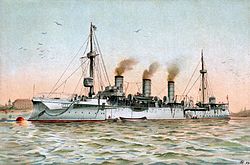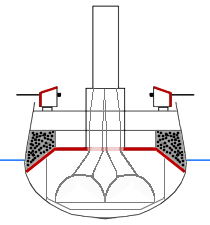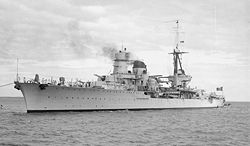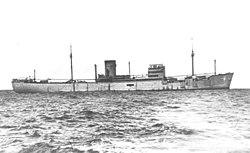Cruiser (warship)
- It should not be confused with a cruise, a passenger ship for vacation.
A cruiser is a type of warship. Today modern cruisers are typically the largest ships available in modern navies (except aircraft carriers), with displacements of 10,000 tons or more.
The term "cruiser," in use for several hundred years, has changed its meaning over time. During the age of sail, the term cruise referred to certain types of missions (independent exploration, trade protection, or assault) carried out by frigates or sloops-of-war, which functioned much like the cruising warships of a fleet.
In the mid-19th century, the cruiser became a classification of ships intended to sail in distant waters, for trade raids and to scout the battle fleet. Cruisers came in a wide variety of sizes, from the medium-sized protected cruiser to large armored cruisers that were nearly as large (though not as powerful or well-armored) as a pre-dreadnought battleship. With the advent of the dreadnought Dreadnought before World War I, the armored cruiser evolved into a similarly scaled ship known as a battlecruiser. The very large battlecruisers of the World War I era that succeeded the armored cruisers were now classified, along with the ironclad battleships, as capital ships.
In the early 20th century, after World War I, direct successors to protected cruisers could be placed on a constant scale of warship size, smaller than a battleship but larger than a destroyer. In 1922, the Washington Naval Treaty imposed a formal limit on these cruisers, which were defined as warships of up to 10,000 tons displacement carrying guns no larger than 8-inch caliber; while the London Naval Treaty of 1930 created a division of two types of cruisers, heavy cruisers had 6.1-inch to 8-inch guns, while those with 6.1-inch or smaller guns were light cruisers. Each type was limited in total and individual tonnage, which shaped cruiser design until the collapse of the treaty system just before the start of World War II. Some variations on the Treaty cruiser design included the "pocket battleships" German Deutschland-class, which had heavier armament at the expense of speed compared to standard heavy cruisers, and the American Alaska-class, which was a larger-scale heavy cruiser design designated a &# 34;cruise killer".
By the late 20th century, the obsolescence of the battleship left the cruiser as the largest surface combat ship and powerful (aircraft carriers are not considered surface combatants, as their attack capability comes from their embarked air wings rather than onboard weapons). The cruiser's role varied by ship and navy, often including air defense and shore bombardment. During the Cold War, the Soviet Navy cruisers had heavy anti-ship missile armament designed to sink NATO carrier task forces via a saturation attack. The US Navy built destroyer-style hulled guided-missile cruisers (some called "destroyer leaders" or "frigates" prior to the 1975 reclassification) designed primarily for provide air defense and often add anti-submarine capabilities, are larger and have longer-range surface-to-air missiles (SAMs) than the early Charles F. Adams guided-missile destroyers tasked with the short-range air defense role. By the end of the Cold War, the line between cruisers and destroyers had blurred, with the Ticonderoga-class cruiser wearing the hull of the Spruance-class destroyer but receiving the cruiser designation due to its improved mission and combat systems.
As of 2020 only two countries operate vessels formally classified as cruise ships: the United States and Russia, and in both cases the vessels are primarily armed with guided missiles. The BAP Almirante Grau was the last gunboat in service, serving with the Peruvian Navy until 2017.
However, classes other than the above may be considered cruisers due to different classification systems. The US/NATO system includes China's Type 055 and Russia's Slava. International Institute for Strategic Studies ' "The Military Balance" defines a cruiser as a surface combatant displacing at least 9,750 tons; includes the Type 055, South Korea's Sejong the Great, Japan's Atago, Slava, Taiwan-operated Kidd, and the US's Zumwalt, Ticonderoga, and Flight III Arleigh Burke.
Unprotected cruise ship
The unprotected cruiser was a type of cruiser used in the late 19th century, during the era of pre-battleships. dreadnought (1880-1905). The names of these ships served to distinguish them from the protected cruisers that had entered service during the 1880s. A protected cruiser does not have side armor on its hull, like a battleship or armored cruiser, but instead has a curved armored deck inside. of its hull —like an internal shell— that prevents enemy shells from going through the ship and hitting vital areas, such as the engine room, boilers and magazine. Instead, the unprotected cruiser lacked this protective cover.
These definitions have some gaps, as some ships could be built with an armored deck that only covered a small area of the ship, or was so thin that it offered little protection (this was also true for the armored belt of some armored cruisers). An unprotected cruiser was generally cheaper and less effective than a protected cruiser, while a protected cruiser was generally cheaper and less effective than an armored cruiser (with some exceptions in each case).
Protected cruise ship
The term cruiser appeared around 1870 to refer to a type of ship with little armor, but fast and well armed, capable of stopping enemy merchant traffic in case of war or protecting its own colonial sea routes overseas in case of necessity. The "protected cruise" (in English protected cruiser) was a ship with an armored deck that curved on the sides slightly protecting the sides of the ship.
They were well armed and were capable of stopping enemy merchant traffic in case of war or protecting their own colonial sea lanes overseas in case of need. They were the nucleus of the colonial squadrons, leaving the battleships as the main ships for front-line naval warfare.
Armored Cruiser
This is an intermediate category, whose heyday only covered the 1890s and the first half of the 1900s. The "armored cruiser" (in English armored cuiser), in addition to using, like the protected cruiser, armor on the deck, coal chests, cannon barbettes and freestanding work, it incorporated protection in the hull, surrounding it with a armor belt or "waist". The main purpose of this innovation was to protect the ship from torpedo attack and cannon hits in the waterline sector. On the other hand, like her predecessor, she was destined for the colonial flotillas.
The first armored cruiser was the Dupuy de Lôme, launched in 1890 at the request of the French Navy. Another famous example is the USS Maine, an armored cruiser that was reclassified as a 2nd class battleship, which exploded for unexplained reasons in the port of Havana.
Armored cruisers starred in the Battle of Ulsan (1904) and did a good job in the Battle of Tsushima (1905), during the Russo-Japanese War. Then, during World War I, two flotillas of armored cruisers clashed in the bloody battle of Coronel. A month after this last encounter, the German armored cruisers SMS Scharnhorst and SMS Gneisenau, winners of the Battle of Coronel, were easily scuttled in the Battle of the Falklands, when they encountered HMS Invincible and HMS Inflexible, English exponents. of the next generation of ships: the "battlecruisers".
Battlecruiser
The appearance, in 1906, of the new British battleship HMS Dreadnought made protected cruisers and armored cruisers completely obsolete overnight. Indeed, the Dreadnought combined armament superior to that of all the battleships built until then, without sacrificing its protection, and also, with its steam turbine power plant, it reached 21 knots, making it as fast as any existing cruiser. This veritable revolution in the art of shipbuilding made the British admiralty consider creating, based on the Dreadnought, a new type of warship: the battlecruiser (battlecruiser in English). This concept was created by Sir John Arbuthnot Fisher. The first battle cruiser was HMS Invincible, which entered service in 1908. This type of ship had a clear function: the hunt for protected and armored cruisers operating against merchant traffic. Generally speaking, a battlecruiser combined the Dreadnought's weaponry with a speed in excess of 25 knots, allowing it to hunt down slower and less well-armed protected cruisers and outrun any enemy that outgunned it. The price paid for such high speed, however, was the sacrifice of armor. HMS Invincible, for example, had vertical armor only 152mm thick: HMS Dreadnought had 280mm thick armor by comparison.
The German navy, alarmed by the appearance of the Invincible, immediately began building its own battlecruisers: the first of these was the SMS Von der Tann, practically a copy of the Invincible. However, German designers did not take kindly to sacrificing the protection of their ships lightly, and German battlecruisers were always much better armored than their British counterparts, since they were also thought to be used as vanguards of the warfare. Fleet. The Von der Tann had 250 mm thick vertical armor.
However, battlecruisers were only used in their original role in the first months of World War I, with great success. Soon after, the British navy decided to use them, like the Germans, as the vanguard of their battle line, a task for which they had not been designed. The result was disastrous, as seen in the Battle of Jutland. Three British battlecruisers were lost: HMS Invincible, HMS Indefatigable and HMS Queen Mary, with their full crews, while the Germans only lost SMS Lützow. We must highlight the ability of German battlecruisers to absorb tremendous damage, the result of the foresight of their designers by sacrificing less armor.
After the war, the British Navy only retained its three most modern battlecruisers: HMS Renown, HMS Repulse and the gigantic HMS Hood. The battlecruiser concept became obsolete with the appearance of the Super-Dreadnought, in the interwar years, since the new battleships built at this time were faster and better armed than any existing battlecruiser. The tragic end of HMS Hood, sunk in the North Atlantic by the German battleship Bismarck, as well as the destruction of HMS Repulse in the China Sea, in May and December 1941, respectively, mark a sad epilogue in the career of one of the most controversial ship types in history.
Heavy Cruiser
Keeping the same concept for colonial use, a cruiser with greater protection and better armor is conceived, the heavy cruiser, capable of acting as a companion to the battleship in important naval battles, with fully armored sides and deck. In the naval treaty that the powers sign in Washington in 1922, her displacement was limited to 10,000 tons and her armament to 203 mm (8 inches). The tonnage was insufficient to provide adequate protection, and during World War II reached in many cases 15,000 t, although the caliber of the guns, suitable for these ships, was maintained.
During the war in the Atlantic, the mission of heavy cruisers was generally to defend merchant traffic against attacks by surface ships, either acting as a direct escort or carrying out oceanic patrol missions. Instead, in the Pacific, heavy cruisers were used by the US Navy to round out the firepower of carrier battlegroups, as US battleships were too slow. Both the Japanese and US fleets created separate fighting forces around their heavy cruisers, to raid enemy merchant traffic. The most representative heavy cruisers were, by country:
- United Kingdom: Class County.
- United States: Des Moines Class.
- Germany: Class Admiral Hipper.
- Italy: Zara Class.
- Japan: Myōkō Class.
- Spain: Canary Class.
The Spanish heavy cruiser Canarias was the last active ship of this class of ships, being decommissioned in 1975.
Light Cruiser
Shortly before the First World War, the protected cruiser gave way to the light cruiser, with a complete armored belt protecting the sides of the ship, but maintaining a contained weight and armament, designed for tasks similar to those of its predecessors and with artillery not exceeding 152mm and less than 10,000t displacement. Her mission was to act as destroyer flotilla directors. To do this they had to be as fast as the destroyers, and their increased artillery firepower allowed them to defend them against enemy destroyers and cruisers, as the destroyers in the Great War were armed mainly with torpedoes and some small caliber guns. This type of ship lasted until the end of World War II: many of those built during World War I were modernized, and development of this type of ship continued through the 1920s and 1930s. Some of the older light cruisers representative, of those built in the interwar period, are:
- Classes Leander, Arethusa and TownBritish.
- Class Königsberg and LeipzigGermans.
- Classes Condottieri and GaribaldiItalian.
- Classes Sendai and AganoJapanese.
- Classes Duguay Trouin and MarseillesFrench.
- Classes Brooklyn and ClevelandAmericans.
- Class KirovRussian.
- Cervera Class, Spanish.
The most important changes introduced in this period were the replacement of coal-fired boilers by others that burned fuel oil, the introduction of electric welding (which made construction lighter by avoiding the use of rivets) and the replacement of the old assemblies gunners shielded by closed turrets.
In World War II, this mission of flotilla command ships remained unchanged, although Admiral (then Captain) Isoroku Yamamoto's theory of close-range naval combat became popular in the early 1930s, advocating abandonment of the 8-inch artillery, replacing it with 6-inch guns, but installing a greater number of pieces on the ship. The result of this theory was a ship with the displacement of a heavy cruiser, but with light cruiser caliber armament. According to this theory, the Japanese navy built the Mogami-class cruisers, armed with fifteen 155mm guns in triple turrets: at four rounds per minute per gun, this was sixty rounds per minute, enough to pulverize any type of destroyer. or cruise a short distance. The British navy adopted this concept, but for different reasons: the tonnage quota for heavy cruisers had been exceeded, so construction began on large light cruisers, which were not subject to the limitations of the Washington and London treaties. However, the destructive power of the 200mm guns was far superior, as was their range, so few navies adopted this type. Examples of this class of large light cruisers are:
- Classes Southampton, Edimburgh and FijiBritish.
- Class MogamiJapanese: just before the outbreak of World War II, the cruises of this series entered the arsenal to change the five triple turrets of 155 mm by so many double turrets of 203 mm, becoming heavy cruises.
- Classes Brooklyn and ClevelandAmericans.
A third type of light cruiser was a class specializing in air defense. These cruisers were developed by the British Navy to improve anti-aircraft defense for convoys and aircraft carrier groups by equipping them with dual-purpose guns (a dual-purpose gun is one that can be used in both surface combat and anti-aircraft defense). The first anti-aircraft cruisers were the Dido-class, armed with 133mm guns in four or five twin turrets. The US Navy used 127 mm guns on its Atlanta-class anti-aircraft cruisers, with up to six double mounts in enclosed turrets (destroyer type). The Italian Navy was also interested in building cruisers of this type, such as those of the Etna series, which were not completed before the Armistice.
Auxiliary Cruiser
These are merchant or passenger ships that in war situations are equipped with weapons to collaborate in the general missions of the fleet as there are usually not enough ships of the line to cover all those assigned. They are used on many occasions as convoy escorts or in surveillance and control missions.
They are also used for the war on traffic. In both world wars the Germans became especially famous, known as corsairs: the passenger ships Kronprinz Wilhelm, Prinz Eitel Fridich or Berlin; the merchantmen Möwe, Wolf or Greif and the sailing ship Seadler in World War I and armed merchantmen (Hilfskreuzer) Atlantis, Coronel, Pinguin, Kormoran, Komet or Michel, among others, in World War II led the war to traffic from the coasts of Greenland to Easter Island.
Their mission, in addition to sinking as many enemy ships as they could, was fundamentally to disrupt the Allied surveillance systems by having to deploy numerous units to monitor, control and try to locate and sink the German ships. In World War II alone, the nine that acted sank or captured 820,715 tons of enemy shipping, including the Royal Australian Navy light cruiser HMAS Sydney; Atlantis holds the navigation record with 20 uninterrupted months (603 sea days), from its departure on March 31, 1940 until its sinking on November 22, 1941.
Missile Cruiser
When the armored navy disappeared shortly after World War II, the cruiser became —due to its size, speed and displacement— the ideal platform to act as a missile launcher. After the conversion of old heavy and light cruisers, the first pure missile cruiser is built, which is also the first nuclear surface ship in history, the American USS Long Beach in 1959, which was followed by other cruiser-style classes, bringing displacement below 10,000 t and adding helicopters for anti-submarine warfare. These cruisers were prepared to attack both planes, other ships or land with various types of missiles, including nuclear in some cases.
For its part, the Soviet Union was not far behind, conceiving the cruiser as a total naval platform capable of assuming any role and acting against any threat, a concept that reached its peak with the Kirov class, begun in 1977, ships of 25,000 t with a number of launchers impossible to find on NATO ships, following the traditional Soviet concept of saturation. Its SS-N-19 Granit anti-ship system simultaneously launches a group of 6 missiles at its target, so that if one is shot down, there are always others that can arrive, anti-aircraft missiles, 130mm automatic guns to support coastal attacks, anti-missile missiles, mine launchers. On another class of cruisers, the kyiv, they added a side deck to make it a mix of anti-submarine and anti-ship cruiser and aircraft carrier.
The Americans hit back with technology. In 1983, the Ticonderoga class of conventionally propelled missile-launching cruisers appeared, with four state-of-the-art components that together form the Aegis combat system: the AN/SPY-1 radar, the computerized command and takeover system the CDS decision system, the ADS target presentation system and the WCS weapons control system. The system is capable of detecting a naval or air target hundreds of miles away, identifying it as friend or foe, and presenting the data to the ship's commander so he can decide whether or not to destroy it.
Since then several of its components have been upgraded, such as new versions of the AN/SPY-1x radar, and improved ground attack capability. The rest of the world's navies are developing similar systems or have adopted —as there is no other operational alternative on the market— versions of the Aegis.
Currently only the United States and Russia maintain cruise ships in their fleets:
- U.S. Navy. U.S.:
• 22× Class Ticonderoga, guided missile cruises. - Russian Navy:
• 2x Kírov Class, missile cruises, sometimes referred to as battle cruises, due to their large size and displacement.
• 3x Slava Class, missile cruises.
• 1x Class Kara, cruise missiles.
Contenido relacionado
Slingshot (weapon)
Blitzkrieg
Battle of Arica












